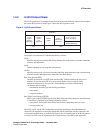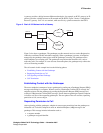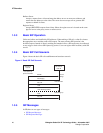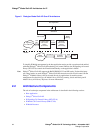Dialogic
®
Global Call IP Technology Guide — November 2007 39
Dialogic Corporation
IP Overview
When all channels between endpoint A and the gateway are closed, each must send a
DisengageRequest (DRQ) message to the gatekeeper. This message lets the gatekeeper know that
the bandwidth is being released. The gatekeeper sends a DisengageConfirm (DCF) message to both
endpoint A and the gateway.
1.3 SIP Overview
Session Initiation Protocol (SIP) is an ASCII-based, peer-to-peer protocol designed to provide
telephony services over the Internet. The SIP standard was developed by the Internet Engineering
Task Force (IETF) and is one of the most commonly used protocols for VoIP implementations. This
section discusses the following topics about SIP:
• Advantages of Using SIP
• SIP User Agents and Servers
• Basic SIP Operation
• Basic SIP Call Scenario
• SIP Messages
1.3.1 Advantages of Using SIP
Some of the advantages of using SIP include:
• The SIP protocol stack is smaller and simpler than other commonly used VoIP protocols, such
as H.323.
• SIP-based systems are more easily scalable because of the peer-to-peer architecture used. The
hardware and software requirements for adding new users to SIP-based systems are greatly
reduced.
• Functionality is distributed over different components. Control is decentralized. Changes made
to a component have less of an impact on the rest of the system.
1.3.2 SIP User Agents and Servers
User agents (UAs) are appliances or applications, such as SIP phones, residential gateways and
software that initiate and receive calls over a SIP network.
Servers are application programs that accept requests, service requests and return responses to
those requests. Examples of the different types of servers are:
Location Server
Used by a SIP redirect or proxy server to obtain information about the location of the called
party.
Proxy Server
An intermediate program that operates as a server and a client and which makes requests on
behalf of the client. A proxy server does not initiate new requests, it interprets and possibly
modifies a request message before forwarding it to the destination.


















